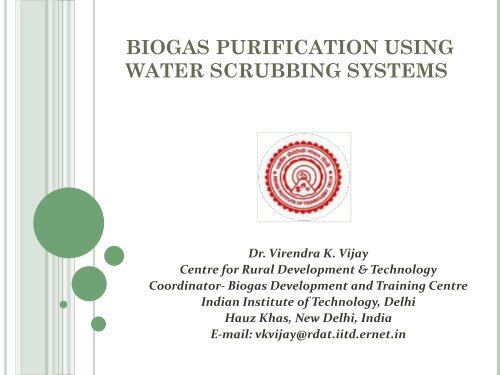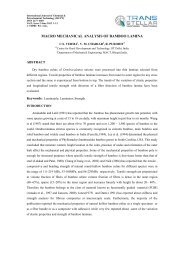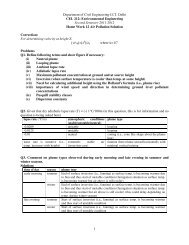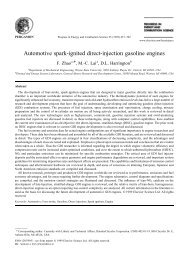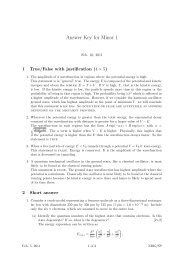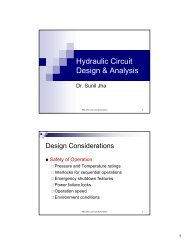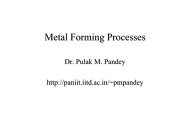biogas purification using water scrubbing systems - Indian Institute ...
biogas purification using water scrubbing systems - Indian Institute ...
biogas purification using water scrubbing systems - Indian Institute ...
Create successful ePaper yourself
Turn your PDF publications into a flip-book with our unique Google optimized e-Paper software.
BIOGAS PURIFICATION USING<br />
WATER SCRUBBING SYSTEMS<br />
Dr. Virendra K. Vijay<br />
Centre for Rural Development & Technology<br />
Coordinator‐ Biogas Development and Training Centre<br />
<strong>Indian</strong> <strong>Institute</strong> of Technology, Delhi<br />
Hauz Khas, New Delhi, India<br />
E‐mail: vkvijay@rdat.iitd.ernet.in
INTRODUCTION<br />
• Biogas is clean environment friendly fuel that can be<br />
obtained by anaerobic digestion of animal residues and<br />
domestic and farm wastes, abundantly available in the<br />
countryside.<br />
• Biogas is an important renewable energy resource for rural<br />
areas in India<br />
• Biogas generally comprise of 55-65 % methane, 35-45 %<br />
carbon dioxide, 0.5-1.0 % hydrogen sulfide and traces of<br />
<strong>water</strong> vapor.<br />
• Average calorific value of <strong>biogas</strong> is 20 MJ/m 3 (4713<br />
kcal/m 3 ).
INTRODUCTION<br />
Biogas like Liquefied Petroleum Gas (LPG) cannot be<br />
liquefied under normal temperature and pressure.<br />
Critical temperature required for liquefaction of methane<br />
is -82.1 o C at 4.71MPa pressure, therefore use of <strong>biogas</strong> is<br />
limited nearby the <strong>biogas</strong> plant.<br />
An estimate indicates that India has a potential of<br />
generating 6.38 X 10 10 m 3 of <strong>biogas</strong> from 980 million<br />
tones of cattle dung produced annually.<br />
The heat value of this gas amounts to 1.3 X 10 12 MJ. In<br />
addition, 350 million tones of manure would also produce<br />
along with <strong>biogas</strong>.
ORGANIC WASTES & THEIR ESTIMATED<br />
AVAILABILITY IN INDIA<br />
Sr.<br />
No.<br />
Organic Wastes Estimated Quantity<br />
1. Municipal Solid waste 30 million tons/year<br />
2. Municipal liquid waste 12000 million litres/day<br />
3. Distillery (243 units) 8057 kilolitres/day<br />
4. Press mud 9 million tons/year<br />
5. Food & fruit processing wastes 4.5 million tons/year<br />
6. Willow dust 30000 tons/year<br />
7. Dairy industry waste 50-60 million litres/day<br />
8. Paper & pulp industry waste (300<br />
mills)<br />
1600 m 3 /day<br />
9. Tannery (2000 units) 52500 m 3 waste <strong>water</strong>/day<br />
Source: MNES Report, Renewable Energy in India and business opportunities, MNES. Govt. of India, New Delhi, 2001
BIOGAS PROGRAMMES<br />
On-going Programmes:<br />
• National Biogas and Manure Management<br />
Programme (NBMMP).<br />
• Biogas Based Distributed/ Grid Power Generation<br />
Programme.<br />
5
BIOGAS PRODUCTION PROCESS<br />
Biogas production process (Anaerobic digestion) is a multiple-stage<br />
process in which some main stages are:<br />
Chemical reactions involved in <strong>biogas</strong> production:<br />
C 6H 12O 6 → 3CO 2 + 3CH 4<br />
CO 2 +4H 2 >CH 4 +2H 2O<br />
CH 3COOH > CH 4 + CO 2
THE QUANTITY, RATE AND COMPOSITION OF BIOGAS<br />
GENERATED DEPENDS ON<br />
The nature and concentration of the substrate,<br />
Feed rate,<br />
pH value,<br />
Bacterial population,<br />
Temperature, and<br />
Chemical inducers.
BIOGAS PRODUCTION POTENTIAL FROM<br />
DIFFERENT WASTES
UTILIZATION OF BIOGAS<br />
Cooking: Biogas can be used in a specially designed burner for cooking<br />
purpose. A <strong>biogas</strong> plant of 2 cubic metres capacity is sufficient for providing<br />
cooking fuel needs of a family of about five persons.<br />
Lighting: Biogas is used in silk mantle lamps for lighting purpose. The<br />
requirement of gas for powering a 100 candle lamp (60 W) is 0.13 cubic metre<br />
per hour.<br />
Power Generation: Biogas can be used to operate a dual fuel engine to<br />
replace up to 80 % of diesel-oil. Diesel engines have been modified to run 100<br />
per cent on <strong>biogas</strong>. Petrol and CNG engines can also be modified easily to use<br />
<strong>biogas</strong>.<br />
Transport Fuel: AfterremovalofCO2,H2Sand <strong>water</strong> vapor, <strong>biogas</strong> can be<br />
converted to natural gas quality for use in vehicles.
BIOGAS DEVELOPMENT AND TRAINING CENTRES<br />
(BDTCS)<br />
For training and publicity purposes, Eleven Biogas<br />
Development and Training Centres (BDTCs) are<br />
functioning, one each in Assam, Himachal Pradesh,<br />
Karnataka, Madhya Pradesh, Punjab; Rajasthan, Tamil<br />
Nadu, Uttar Pradesh, West Bengal and Uttarakhand.<br />
One BDTC has been started in IIT Delhi in 2008.<br />
Central financial assistance is provided to these Centres<br />
for staff and training courses.<br />
BDTCs focus on the training of masons and<br />
entrepreneurs to improve quality of construction of<br />
<strong>biogas</strong> plants and to follow standard specifications &<br />
approved construction techniques.
NEED FOR THE BIOGAS REFINING AND<br />
BOTTLING<br />
Potential of <strong>biogas</strong> is not fully utilized and commercialized so far.<br />
For commercialization, its area of application may widen; from<br />
cooking fuel to vehicle fuel.<br />
For use as a vehicle fuel, it should be bottled like CNG.<br />
Before bottling, it should enriched in methane content from 55 %<br />
to 95 %; similar to CNG.
CO 2 & H 2S REMOVAL PROCESSES FROM BIOGAS<br />
Process Advantage Disadvantage<br />
PSA Economy in production with comparatively<br />
high purity. Capital costs are moderate.<br />
Relatively quick installation and start up.<br />
Water<br />
Scrubbing<br />
Simple process, remove both H 2SandCO 2<br />
<strong>using</strong> a <strong>water</strong> stream.<br />
Not much scalability in production.<br />
Equipment maintenance on the higher<br />
side ,Chemical regeneration is required<br />
High pressure, difficulty in recovery of<br />
CO 2<br />
Cryogenic High purity . Capital cost high. Requirement of<br />
large sites. Longer start-up and shut<br />
down process. Limited scalability in<br />
production.<br />
Membrane Fast installation and start up .Production of<br />
Economically not viable. Not suitable<br />
output is flexible .Purity and flow rate can for high purity needs. Consumes<br />
vary.<br />
relatively more electricity per unit of<br />
gas produced.<br />
Chemical<br />
Absorption<br />
The chemical absorbents are more efficient<br />
in low pressure<br />
Regeneration of the solvent requires a<br />
relatively high energy input. Disposal<br />
of by product formed due to chemical<br />
reaction is a problem
THE DESIGNING OF THE PACKED BED SCRUBBER<br />
INVOLVED THE FOLLOWING STEPS:<br />
Assumptions of basic data<br />
Solubility data generation<br />
Material balance and determination of <strong>water</strong> flow rate<br />
Selection of packing material<br />
Determination of column diameter<br />
Determination of the height of the packed bed column<br />
Selection of packing support and <strong>water</strong> distributor
WORKING OF SCRUBBING SYSTEM<br />
Water <strong>scrubbing</strong> method is found most suitable<br />
for <strong>biogas</strong> enrichment in rural areas.<br />
Water is good solvent for CO 2.<br />
The solubility of CO 2 in <strong>water</strong> is governed by<br />
variation in pressures and temperatures.
SYSTEM OPERATION<br />
Raw <strong>biogas</strong> is compressed up to 1.0 MPa<br />
pressure to enhance solubility of CO 2 in <strong>water</strong>.<br />
Pressurized <strong>biogas</strong> is sent into bottom section of<br />
the scrubber.<br />
Packing material is used to enhance the contact<br />
time (interfacial area) between gas and <strong>water</strong>.<br />
Pressurized <strong>water</strong> is sprayed from top to absorb<br />
the CO 2 from pressurized <strong>biogas</strong>.
COMPRESSION UNIT<br />
Multi stage compressor : compression of<br />
methane enriched <strong>biogas</strong> at 20 MPa Pressure<br />
in cylinder.<br />
Filters : for moisture removal.<br />
Cylinders: High pressure, seamless, steel<br />
cylinders that are already in being use for<br />
CNG application.<br />
Pipe fittings and accessories : G.I.
Water Tank<br />
Pump<br />
Biogas<br />
Digester<br />
Biogas (CH 4 CO 2) Moisture Removal<br />
Flow Meter<br />
Single Stage Compressor<br />
Gas Storage Pressure Vessel<br />
Water<br />
Biogas Scrubber<br />
Gas Storage Pressure Vessel<br />
Moisture Filters<br />
Pressure Reducers<br />
Three Stage Gas<br />
Compressor<br />
Dissolved CO2 in<br />
Water<br />
Enriched Biogas<br />
High Pressure Cylinders for Storage of Enriched<br />
Gas
BIOGAS ENRICHMENT AND BOTTLING<br />
SYSTEM<br />
1-Biogas plant<br />
11-Safety valve<br />
2-Ball valve<br />
12-Water sprayer<br />
3-Water remover<br />
13-Flange<br />
4-Receiver mounted compressor 14-View glass<br />
5-Pressure gauge<br />
15-Water outlet<br />
6-Gas Storage Vessel<br />
16-Water pump<br />
7-Rotameter<br />
17-Gas filter<br />
8-Supporting stand<br />
18-Pressure reducer<br />
9-Reshching rings<br />
19-Three stage gas compressor<br />
10-Scrubber<br />
20-CNG Cylinder<br />
1<br />
2<br />
3<br />
5<br />
4<br />
6 7<br />
Fig.1: Experimental setup for <strong>biogas</strong> <strong>purification</strong> and bottling<br />
9<br />
12<br />
10<br />
11<br />
15<br />
8<br />
13<br />
16<br />
14<br />
NOT TO SCALE<br />
17<br />
20<br />
18<br />
19
Water Out<br />
Enriched Biogas<br />
Water In<br />
Raw Biogas<br />
CO 2 SCRUBBING SYSTEM<br />
Top Section<br />
Middle Section<br />
Bottom Section<br />
500<br />
mm<br />
3500<br />
mm<br />
800<br />
mm<br />
150<br />
mm<br />
Not to scale<br />
Enriched<br />
Biogas<br />
Water In<br />
Packing<br />
Supporting<br />
Stand<br />
Raw<br />
Biogas<br />
Water Out<br />
Schematic Diagram of Packed Bed Column
SUCCESS CASE STUDIES OF BIOGAS AS AUTOMOTIVE<br />
FUEL<br />
•Rajasthan Go Sewa Sangh, Durgapura, Rajasthan:<br />
•Plant started in 2007 and has been running successfully. A three<br />
wheeler runs on <strong>biogas</strong> daily about 100 km. and approximate 4 kg<br />
Bio-CNG is required.<br />
•Shri Krishna Goshala, Ghaziabad:<br />
•Plant started in 2009 and has been running successfully.<br />
•<br />
•Shri Madhav Go Vigyan Anusandhan Sansthan, Bhilwara,<br />
Rajasthan:<br />
•Plant started in 2009 and has been running successfully.
AUTOMOTIVE CAR AND THREE WHEELER<br />
RUNNING ON ENRICHED BIOGAS
COST-ECONOMICS OF THE SYSTEM<br />
The Cost of Biogas plant (1000 NM 3 /Day Capacity) is<br />
approx. Rs. 60 lakhs<br />
Biogas <strong>purification</strong> and bottling system is approx. Rs. 55<br />
lakhs (excluding the cost of cylinder for gas storage)<br />
slurry management and processing cost to produce dry<br />
manure is Rs. 20 Lakhs<br />
other costs like land preparation, civil work, high<br />
pressure gas storage cylinders Taxes, logistic etc. is<br />
appox. Rs.15 Lakhs.<br />
total initial cost is Rs. 1.5 Crores of the whole system<br />
with annual profit of approx. Rs. 34.125 Lakhs.
POSSIBLE ENTREPRENEURIAL AVENUES<br />
Large Scale/ Community level Biogas Enterprises for<br />
1. Cooking needs- Pipeline supply<br />
2. Electricity Production and Supply<br />
3. Rural sanitation & bio manure production<br />
4. Cylindering of methane available from <strong>biogas</strong> plant for vehicles<br />
and production of bio manure
CONCLUSIONS<br />
India has second largest <strong>biogas</strong> programme in the world at rural and<br />
as well as urban levels.<br />
Many technologies/models have been successfully developed in<br />
India for <strong>biogas</strong> programme.<br />
There is need to develop a sustainable renewable energy programme<br />
on <strong>biogas</strong> for replacing petroleum products by utilization of <strong>biogas</strong><br />
in the country.<br />
This will help in green energy technology and reducing green house<br />
gases emissions.
Biogas is a potential renewable energy source for rural India and<br />
other developing countries.<br />
Biogas generation and subsequent bottling will cater the energy<br />
needs of villages, supply enriched manure and maintain village<br />
sanitation.<br />
The bottling system will work as a decentralize source of power<br />
with uninterrupted supply <strong>using</strong> local resources, generate ample<br />
opportunities for employment and income of the rural people.
THANK<br />
YOU


